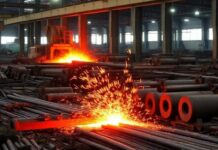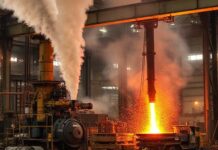The Naveen Jindal Group is in the final stages of crafting a Rs 15,000 crore investment blueprint aimed at bolstering its renewable energy portfolio, a move set to serve as a source of captive clean fuel for its expanding steelmaking operations. This strategic initiative aligns with the group’s recent announcement of a significant capacity expansion plan, which could potentially increase its steelmaking capacity to around one and a half times its current size by the end of the fiscal year 2025-26.
The forthcoming blueprint outlines the group’s intention to power the new steel capacity additions by establishing 4 gigawatts (GW) of renewable power sources in-house within the next few years. This strategic move aims to reduce carbon emissions and facilitate the production of green steel, contributing to environmental sustainability.
Notably, the steel industry is responsible for nearly 8 per cent of global carbon emissions, with a substantial portion stemming from the use of fossil fuel-based power sources. The Naveen Jindal Group’s commitment to renewable energy signifies a significant step towards reducing its carbon footprint and promoting sustainable practices in its operations.
The new capacities are slated to be developed under Jindal Renewable Power Private Limited, a subsidiary of the group, according to an Economic Times report. This subsidiary will focus on harnessing renewable energy sources such as solar and wind power, with sites already earmarked and land acquisition processes currently underway in Rajasthan and Karnataka.
In addition to focusing on renewable energy, the group is also emphasizing ESG (environmental, social, and governance) compliance in response to evolving market demands. This initiative is driven by investor pressure to reduce carbon emissions and align with international sustainability standards.
The group’s commitment to ESG compliance is reflected in its plans to invest in green technologies to decarbonize its steel business. The additional steelmaking capacity is primarily directed towards the production of hot-rolled and cold-rolled steel, which are used in rapidly expanding sectors such as automotive and construction.





